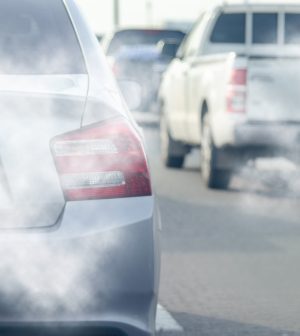- See What Saffron Can Do for Sleep and Heart Health
- 6 Common Mistakes to Avoid Before Your Physical
- Can Sweating Really Help You Beat a Cold?
- Strengthening Your Relationship: Practical Strategies
- Skip Storing This Everyday Product in the Fridge Door
- Green Tea + B3 Pairing May Boost Brain Health
- Navigating Your Midlife Crisis: Embracing New Possibilities
- City Raccoons Showing Signs of Domestication
- Mapping the Exposome: Science Broadens Focus to Environmental Disease Triggers
- One Week Less on Social Media Linked to Better Mental Health
Do You Live in One of America’s Worst Cities for Dirty Air?

Nearly one-third of Americans live in counties with unhealthy air, according to a new report from the American Lung Association.
One in three, or 120 million, people lives with unhealthy levels of ozone or particle pollution, the “State of the Air” report says.
While air quality has improved overall, there are major differences between Eastern and Western states and in air pollution exposure for white people and people of color, according to the association.
“The good news is that ozone pollution has generally improved across the nation, thanks in large part to the success of the Clean Air Act. In this year’s ‘State of the Air’ report, we found that 19.3 million fewer people are living in areas with unhealthy levels of ozone pollution, also known as smog,” said Harold Wimmer, national president and CEO of the association.
“However, the fact is that 120 million people still live in places with unhealthy air pollution, and not all communities are seeing improvements. This is why it is crucial to continue our efforts to ensure that every person in the U.S. has clean air to breathe,” Wimmer added in an association news release.
The report, which covers 2019 to 2021, found about 54% of those living with unhealthy air quality were Black Americans and other minorities. People of color were 64% more likely to live in a county with a failing grade for at least one measure, and they were 3.7 times as likely to live in a county with a failing grade for all three measures: unhealthy levels of ground-level ozone air pollution, annual particle pollution and short-term spikes in particle pollution over a three-year period.
This was an increase compared to last year’s report.
Conditions were worse in Western than Eastern states, where more than 18 million residents live in counties with three failing grades. The worst 25 counties for short-term particle pollution are in the Western United States.
The lung association noted that fine particulate matter, or PM2.5, air pollution can be deadly. These unhealthy particles in the air come from wildfires, wood-burning stoves, coal-fired power plants, diesel engines and other sources. They can trigger asthma attacks, heart attacks and strokes and cause lung cancer.
Almost half a million more people lived in counties that experienced unhealthy spikes in particle pollution in this report than in the previous year’s report.
The top five cities most impacted by short-term particle pollution, or daily pollution spikes, were Bakersfield, Calif.; Fresno-Madera-Hanford, Calif.; Fairbanks, Alaska; Visalia, Calif., and Reno-Carson City-Fernley, Nev.
While 1.5 million fewer people were living in a county that received a failing grade for annual particle pollution, 18.8 million people still lived in a county with a failing grade. The top five cities most polluted with year-round particles were Bakersfield, Calif.; Visalia, Calif.; Fresno-Madera-Hanford, Calif; Los Angeles-Long Beach, Calif., and Fairbanks, Alaska.
Ground-level ozone pollution is an irritant to the lungs and can cause shortness of breath, coughing and asthma attacks. It may shorten your life.
Warmer temperatures driven by climate change make ozone more likely to form and harder to clean up, according to the report. About 103 million people live in an area with unhealthy ozone pollution, which is 19.3 million fewer than in the previous year’s report.
The top five cities most affected by ozone pollution include four in California: Los Angeles-Long Beach; Visalia; Bakersfield, and Fresno-Madera-Hanford, plus Phoenix-Mesa, Ariz.
The cleanest U.S. cities were Asheville-Marion-Brevard, N.C.; Bangor, Maine; Greenville-Kinston-Washington, N.C.; Lincoln-Beatrice, Neb.; Rochester-Batavia-Seneca Falls, N.Y.; urban Honolulu, Hawaii, and Wilmington, N.C.
The “State of the Air” report relies on data from air quality monitors managed by state, local and tribal air pollution control authorities. However only 922 counties out of 3,221 are able to monitor for at least one pollutant.
More than 71 million people live in counties where their ozone and particle pollution levels are not monitored.
The lung association is asking President Biden to move forward on several measures to clean up air pollution nationwide. These include new limits on ozone and particle pollution and new measures to clean up power plants and vehicles.
More information
The U.S. Environmental Protection Agency has more on PM2.5.
SOURCE: American Lung Association, news release, April 19, 2023
Source: HealthDay
Copyright © 2025 HealthDay. All rights reserved.










